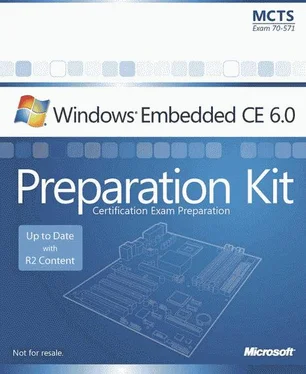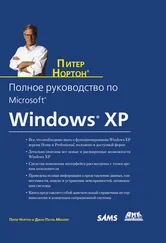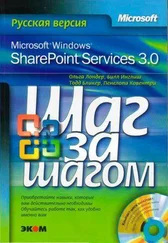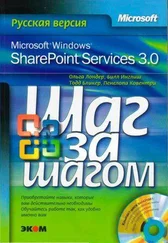Nicolas Besson - Microsoft Windows Embedded CE 6.0 Exam Preparation Kit
Здесь есть возможность читать онлайн «Nicolas Besson - Microsoft Windows Embedded CE 6.0 Exam Preparation Kit» весь текст электронной книги совершенно бесплатно (целиком полную версию без сокращений). В некоторых случаях можно слушать аудио, скачать через торрент в формате fb2 и присутствует краткое содержание. Город: Redmond, Год выпуска: 2008, Издательство: Microsoft, Жанр: Руководства, ОС и Сети, Программы, на английском языке. Описание произведения, (предисловие) а так же отзывы посетителей доступны на портале библиотеки ЛибКат.
- Название:Microsoft Windows Embedded CE 6.0 Exam Preparation Kit
- Автор:
- Издательство:Microsoft
- Жанр:
- Год:2008
- Город:Redmond
- ISBN:нет данных
- Рейтинг книги:5 / 5. Голосов: 1
-
Избранное:Добавить в избранное
- Отзывы:
-
Ваша оценка:
- 100
- 1
- 2
- 3
- 4
- 5
Microsoft Windows Embedded CE 6.0 Exam Preparation Kit: краткое содержание, описание и аннотация
Предлагаем к чтению аннотацию, описание, краткое содержание или предисловие (зависит от того, что написал сам автор книги «Microsoft Windows Embedded CE 6.0 Exam Preparation Kit»). Если вы не нашли необходимую информацию о книге — напишите в комментариях, мы постараемся отыскать её.
Microsoft Windows Embedded CE 6.0 Exam Preparation Kit — читать онлайн бесплатно полную книгу (весь текст) целиком
Ниже представлен текст книги, разбитый по страницам. Система сохранения места последней прочитанной страницы, позволяет с удобством читать онлайн бесплатно книгу «Microsoft Windows Embedded CE 6.0 Exam Preparation Kit», без необходимости каждый раз заново искать на чём Вы остановились. Поставьте закладку, и сможете в любой момент перейти на страницу, на которой закончили чтение.
Интервал:
Закладка:
■ Microsoft Windows XP SP2 or Windows Vista.
■ Microsoft Visual Studio 2005 Professional Edition.
■ Microsoft Windows Embedded CE 6.0.
■ Microsoft Visual Studio 2005 Professional Edition SP1.
■ Microsoft Windows Embedded CE 6.0 SP1.
■ Microsoft Windows Embedded CE 6.0 R2.
Installation guidelines and evaluation versions of Visual Studio 2005 and Windows Embedded CE 6.0 are available on the Microsoft Website, at http://www.microsoft.com/windows/embedded/products/windowsce/getting-started.mspx.
■ Characters or commands that you type appear in bold lowercasetype.
■ in syntax statements indicate placeholders for variable information.
■ Italic is used for book titles and Web addresses.
■ Names of files and folders appear in Title Caps, except when you are to type them directly. Unless otherwise indicated, you can use all lowercase letters when you type a file name in a dialog box or at a command prompt.
■ File name extensions appear in all lowercase.
■ Acronyms appear in all uppercase.
■ Monospace type represents code samples, examples of screen text, or entries that you might type at a command prompt or in initialization files.
■ Square brackets [ ] are used in syntax statements to enclose optional items. For example, [ filename ] in command syntax indicates that you can choose to type a file name with the command. Type only the information within the brackets, not the brackets themselves.
■ Braces { } are used in syntax statements to enclose required items. Type only the information within the braces, not the braces themselves.
■ A plus sign (+) between two key names means that you must press those keys at the same time. For example, "Press ALT+TAB" means that you hold down ALT while you press TAB.
■ A comma (,) between two or more key names means that you must press each of the keys consecutively, not together. For example, "Press ALT, F, X" means that you press and release each key in sequence. "Press ALT+W, L" means that you first press ALT and W together, and then release them and press L.
■ You can choose menu commands with the keyboard. Press the ALT key to activate the menu bar, and then sequentially press the keys that correspond to the highlighted or underlined letter of the menu name and the command name. For some commands, you can also press a key combination listed in the menu.
■ You can select or clear check boxes or option buttons in dialog boxes with the keyboard. Press the ALT key, and then press the key that corresponds to the underlined letter of the option name. Or you can press TAB until the option is highlighted, and then press the spacebar to select or clear the check box or option button.
■ You can cancel the display of a dialog box by pressing the ESC key.
Several types of Notes appear throughout the lessons.
■ Notes marked Tipcontain explanations of possible results or alternative methods.
■ Notes marked Importantcontain information that is essential to completing a task.
■ Notes marked Notecontain supplemental information.
■ Notes marked Cautioncontain warnings about possible loss of data.
■ Notes marked Exam Tipcontain helpful hints about exam specifics and objectives.
The Companion CD contains a variety of informational aids that may be used throughout this book. This includes worksheets with detailed step-by-step instructions and source code used in hands-on exercises, as well as complimentary technical information and articles from the Microsoft developers.
An electronic version (eBook) of this book is included with a variety of viewing options available. The Companion CD also contains a complete set of post-press files for this official self-paced study guide to produce a printed book. The post-press files are in Portable Document Format (PDF) and have the required crop marks for professional printing and binding.
The Microsoft Certified Professional (MCP) program provides the best method to prove your command of current Microsoft products and technologies. The exams and corresponding certifications are developed to validate your mastery of critical competencies as you design and develop, or implement and support, solutions with Microsoft products and technologies. Computer professionals who become Microsoft certified are recognized as experts and are sought after industry-wide. Certification brings a variety of benefits to the individual, employers, and organizations.
For a full list of Microsoft certifications, go to http://www.microsoft.com/learning/mcp/default.asp .
Every effort has been made to ensure the accuracy of this book and the contents of the companion CD. If you have comments, questions, or ideas regarding Windows Embedded CE development, contact a Windows Embedded CE specialist through Microsoft Product Support Services (PSS), Microsoft Developer Network (MSDN), or the following blog sites:
■ Nicolas BESSON's WeblogContact the principal author of the Windows Embedded CE 6.0 Exam Preparation Kit with feedback and subject suggestions for new articles related to those subjects at http://nicolasbesson.blogspot.com .
■ Windows Embedded BlogRead about Mike Halls tricks, tips, and random thoughts on Windows Embedded at http://blogs.msdn.com/mikehall/default.aspx .
■ Windows CE Base Team BlogGet background information about Windows Embedded CE kernel and storage technologies and system tools directly from the Microsoft developers at http://blogs.msdn.com/ce_base/default.aspx .
For detailed information about all available Windows Embedded CE product support options, go to http://www.microsoft.com/windows/embedded/support/products/default.mspx.
Chapter 1
Customizing the Operating System Design
Whenever you want to deploy Windows® Embedded CE 6.0 R2 on a target device, you must use a run-time image that includes the necessary operating system (OS) components, features, drivers, and configuration settings. The run-time image is the binary representation of the OS design. You can use Microsoft® Platform Builder for Windows Embedded CE 6.0 to create or customize an OS design and generate the corresponding run-time image. For each OS design, you typically create a new development project in Microsoft® Visual Studio® 2005 and include only the necessary components for your target device and applications. This helps to reduce the footprint of the operating system and to lower hardware requirements. However, in order to generate compact and functional run-time images, you must have an intimate understanding of Platform Builder, including the user interface (UI), the catalog components, and the specifics of the build procedure. This chapter covers these aspects by explaining how to create an OS design and generate a new Windows Embedded CE run-time image.
Exam objectives in this chapter:
■ Creating and customizing OS designs
■ Configuring Windows Embedded CE subprojects
■ Cloning components
Читать дальшеИнтервал:
Закладка:
Похожие книги на «Microsoft Windows Embedded CE 6.0 Exam Preparation Kit»
Представляем Вашему вниманию похожие книги на «Microsoft Windows Embedded CE 6.0 Exam Preparation Kit» списком для выбора. Мы отобрали схожую по названию и смыслу литературу в надежде предоставить читателям больше вариантов отыскать новые, интересные, ещё непрочитанные произведения.
Обсуждение, отзывы о книге «Microsoft Windows Embedded CE 6.0 Exam Preparation Kit» и просто собственные мнения читателей. Оставьте ваши комментарии, напишите, что Вы думаете о произведении, его смысле или главных героях. Укажите что конкретно понравилось, а что нет, и почему Вы так считаете.








